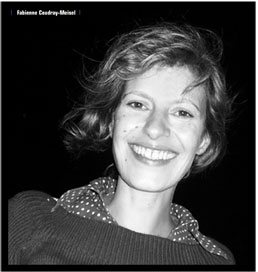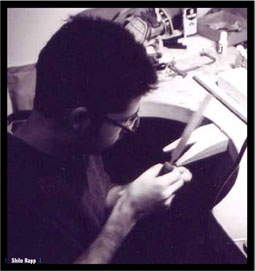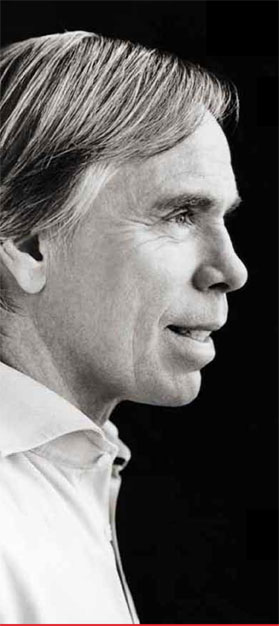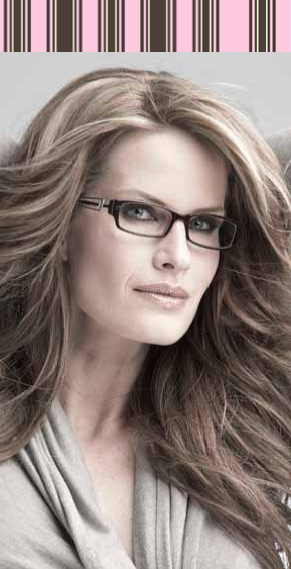By Paddy Kamen
 Imagine a much-loved little girl waltzing around with her mother’s hats, scarves and stoles. Imagine her mother’s delight in dressing her up for a party. Now imagine that this mother is a couturier designer with one of Spain’s most prestigious houses – Balenciaga.
Imagine a much-loved little girl waltzing around with her mother’s hats, scarves and stoles. Imagine her mother’s delight in dressing her up for a party. Now imagine that this mother is a couturier designer with one of Spain’s most prestigious houses – Balenciaga.
The little girl grew up to be one of the great talents in the world of eyewear design: Fabienne Coudray-Meisel, creator of the Volte Face brand and a partner with the illustrious J.F. Rey.
Fabienne showed an early interest in art and interior design: “I was always rearranging the furniture and pictures in my bedroom and making all kinds of things from my imagination,” she explains. “And when I was 12, my grandmother gave me a sewing machine and I started to design and make my own apparel, which I do to this day.”
Coudray-Meisel trained as an optician and worked as a buyer in the industry before discovering her true calling as a designer. “I attended the Parsons design school in New York where I obtained my Masters degree. I then started my company, Volte Face, in 1998, growing it slowly and focusing on creating good designs as well as excellent relationships with customers and suppliers. Then, in 2010, I decided to share my skill and philosophy with the J.F. Rey group. They have extensive experience in design and distribution and I am sharing the best of that.”
Audrey Larbot, spokesperson for J.F. Rey, characterizes the relationship between her company and Coudray-Meisel as, “a fortuitous union. With the expertise of Rey’s in-house designers and manufacturers, partner suppliers and the latest technological innovations at her disposal, Fabienne Coudray-Meisel’s creativity is boundless.”
Coudray-Meisel is most assuredly an imaginative designer and her newest collections were turning heads at the 2012 editions of MIDO in Milan, and Vision Expo East (VEE) in New York. Sarah Braida, president of J.F. Rey Canada, is absolutely delighted with the newest work. “Coudray-Meisel’s work and brand is a perfect complement to the J.F. Rey and Boz collections. I see it as appealing to a different customer, perhaps a woman with more discreetly chic or philosophical inclinations. And these frames are designed for a smaller face, which has been lacking in the Canadian market. They’re also deep enough for progressive lenses. Overall, I’d say this collection is very feminine. They’re not for every retailer, nor are they for every customer, yet I know they will be strong sellers.”
The new frame designs draw their inspiration from many sources, notes Coudray-Meisel. From the architectural mobile sculptures of the late American artist Alexander Calder to the ‘witches mirror’ or ‘miroir de sorcière’ of French designer Chaty Vallauris, to industrial panels and glass vases from Murano, Italy, the world is chock-full of designs that speak to Coudray-Meisel who will stop at nothing to translate her dreams into reality. “I want people to say ‘wow’ when they see the frames and ‘wow’ again when they put them on,” she says.
Laser engraving is one outstanding surface finish you’ll see on acetate front temples to dazzling effect, with geographic patterns and criss-crossing lines and circles in the Templa, Tildia, Tyler and Twig models. Sculptural, tiered, petal-like pieces are layered on the Urika for a subtle, elegant effect.
And luxurious jewelry is recalled in the minimalist, yet sophisticated Usuki and similar models, with laser technology leaving slight variations in the acetate.
Fluid lines, structural contract, surprising patinas and astute use of colour all combine to create a je ne sais quoi that is worthy of the ‘wow factor’ Coudray-Meisel aspires to.
Sarah Braida will be rolling out the new Volte Face collection with a Quebec start this spring, to a country-wide hello into the autumn. “We’ll be receiving the models from the MIDO and VEE shows soon. The final pieces will be unveiled at Silmo in September, and Volte Face will be seen at retailers as soon as possible thereafter,” says Braida.
Creativity is nothing without passion and, as Braida says, “Fabienne has a new-found passion that is truly evident in her designs. She’s doing a wonderful job.”
One sad note in the life of Fabienne Coudray-Meisel, is that her beloved mother passed away when Fabienne was still a child. But the positive life force of the child, Fabienne, grew and flourished and she is now an influential designer in her own right.
“My mother’s elegance and her joie de vivre inspired me forever,” says Coudray-Meisel. “In my work I try to give life to my mother’s dreams and to inspire my own daughter to live a creative life as well.”
Now imagine Fabienne Coudray-Meisel living a long and rich life, creating beautiful objects for the world. And dancing with her daughter.







